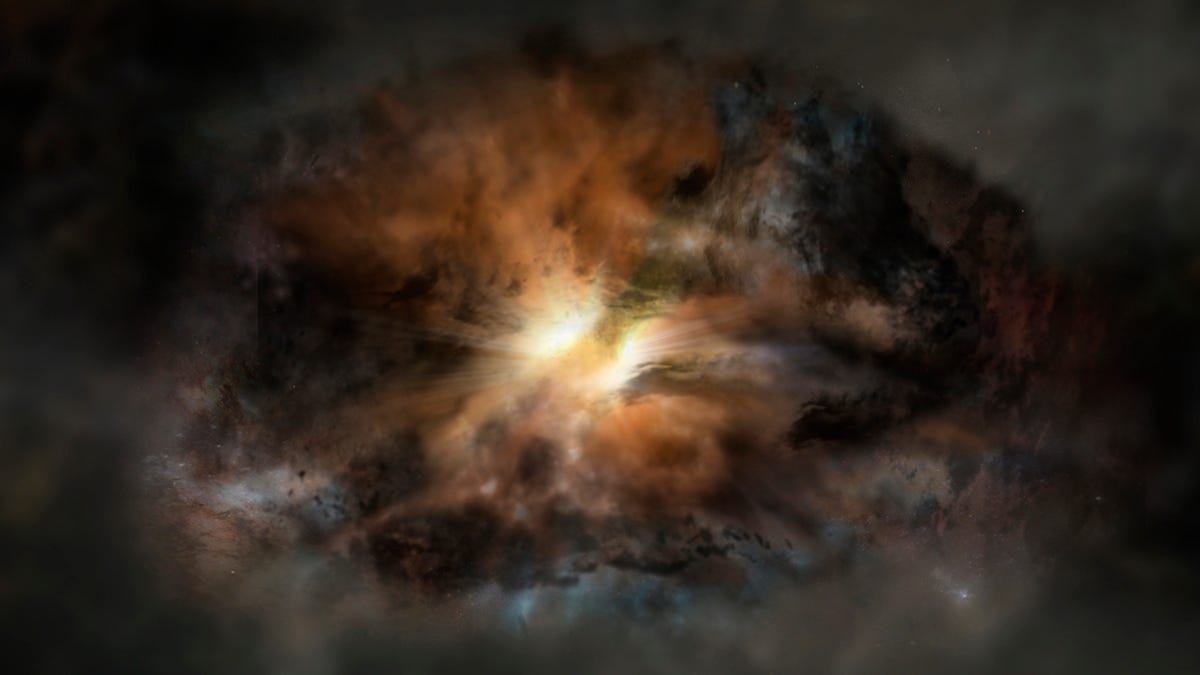Queasy quasar: Turbulent galaxy upchucks its star-making material
The most luminous galaxy in the universe is a roilingly turbulent quasar in the process of ejecting all its star-forming gas.
A galaxy that emits more infrared light than 350 trillion suns is in such an agitated state that it is boiling away all of its interstellar gas.
W2246-0526 is what is known as a quasar, some of the most active and energetic objects in the universe. They generally form when two galaxies collide, and the black holes in the centre of these galaxies become either a binary black hole, or merge to form one supermassive black hole.
At a distance of 12.4 billion light-years from Earth, and just one billion years younger than the universe, W2246-0526 remained unknown until May of last year, when its discovery was published. For such a luminous object, that might seem strange, but its luminosity isn't the only thing that makes W2246-0526 special. It is also a rare formation known as a Hot DOG, or Hot, Dust-Obscured Galaxy. As its name suggests, it's hidden from normal view by a cloud of dust.
To peer inside W2246-0526, scientists from NASA's Jet Propulsion Laboratory used the WISE telescope's infrared instrument to find the quasar, while scientists from the European Southern Observatory used the ALMA radio telescope to closely map what was happening inside the dust cloud.
What they found confirmed a supermassive black hole, around which turbulently swirls an incredibly active and energetic accretion disc. This accretion disc is superheated by the swirling activity caused by the black hole. This, in turn, causes the galaxy to glow extremely brightly. It is the dust cloud around it that absorbs the brightness, re-emitting it as infrared light.
"These properties make this object a beast in the infrared," said Universidad Diego Portales astronomer Roberto Assef, leader of the ALMA team. "The powerful infrared energy emitted by the dust then has a direct and violent impact on the entire galaxy, producing extreme turbulence throughout the interstellar medium."
This interstellar medium, the gas and material used in star formation, is not part of the accretion disc, and it is rocketing about inside the galaxy at extreme speeds.
"Large amounts of this interstellar material were found in an extremely turbulent and dynamic state, careening throughout the galaxy at around two million kilometres per hour," explained lead author Tanio Díaz-Santos.
This turbulence, the team believes, is because of the luminosity of that tiny accretion disc. It's 100 times brighter than the rest of W2246-0526 combined, the most extreme accretion disc ever seen in a quasar. The resulting radiation greatly disrupts the entire galaxy. The team compared it to a pot boiling dry. If the turbulent conditions inside the quasar continue, it will eventually eject all its star-forming material.
"This galaxy is tearing itself apart. The momentum and energy of the particles of light deposited in the gas are so great that they are pushing the gas out in all directions," Assef said.
"A likely finale would be that the galaxy will blow out all of the gas and dust that is surrounding it, and we would see the accretion disk without its dust cover -- what we call a quasar."
There are two outcomes for W2246-0526. It will either eject the matter so strongly that it leaves the galaxy never to return, or the matter will fall back towards the galaxy, collpasing into a more familiar form.
"If this pattern continues, it is possible that W2246-0526 will eventually mature into a more traditional quasar," concludes Manuel Aravena, also from the Universidad Diego Portales. "Only ALMA, with its unparalleled resolution, can allow us to see this object in high definition and fathom such an important episode in the life of this galaxy."
The team's paper was published in Astrophysical Journal Letters, and can be read in full on the ESO's website.


